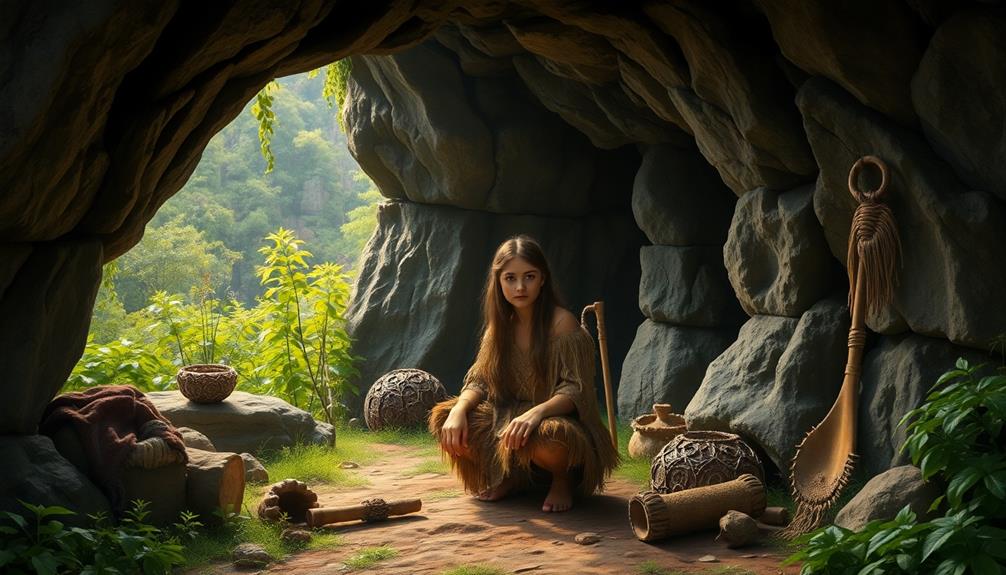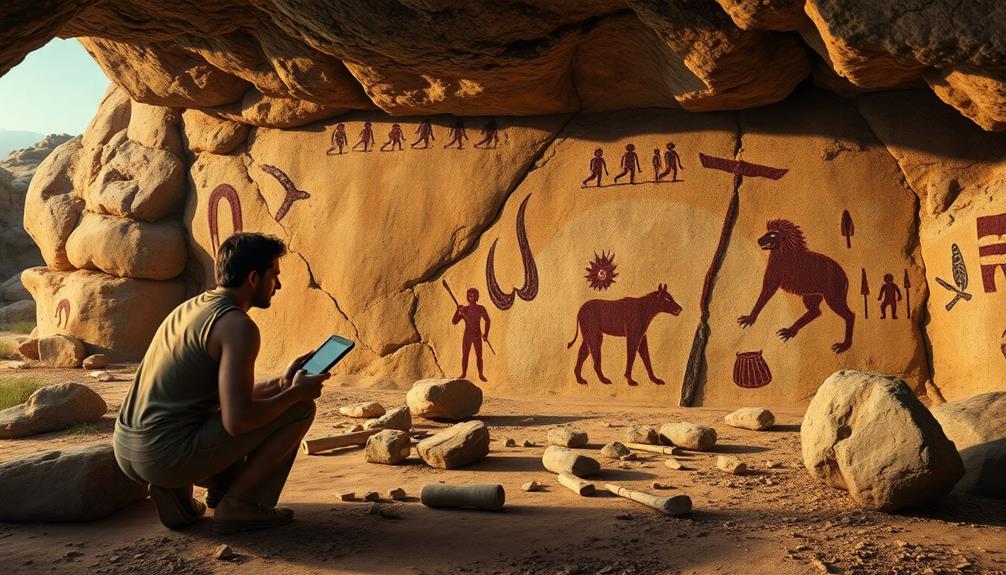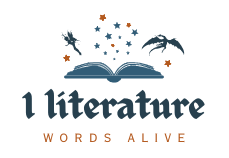You've come to learn about Jean M. Auel, the creative mind behind "The Clan of the Cave Bear." She immerses you in a prehistoric world through Ayla, a young Cro-Magnon girl facing survival challenges after losing her family. Auel's background in anthropology drives her vivid storytelling, blending historical accuracy with enthralling narratives. The book tackles profound themes like identity, cultural conflict, and resilience amidst societal constraints. Since its release, it's sold over 45 million copies, inspiring readers worldwide. There's so much more to explore regarding Auel's journey and the impact of her remarkable work.
Overview of the Novel
In "The Clan of the Cave Bear," you immerse yourself in the life of Ayla, a young Cro-Magnon girl who faces the harsh realities of a prehistoric world after losing her family to an earthquake. Set during the Upper Paleolithic period, the novel investigates Ayla's struggle for survival among a Neanderthal clan.
As she navigates her new environment, you witness her adaptation to the clan's social structure, learning to communicate through gestures and grappling with her identity. This narrative echoes the themes of resilience and strength found in the courageous stories of survival explored in other works, illustrating the timeless human spirit in the face of adversity.
The clash between the Cro-Magnons and Neanderthals highlights the cultural conflict central to the story. You explore themes of survival, identity, and societal norms, including gender roles prevalent in prehistoric settings.
Ayla's journey exemplifies resilience as she learns to find her place within the Clan while confronting challenges that test her spirit.
Jean M. Auel's "The Clan of the Cave Bear," the first book in the Earth's Children series, has sold over 45 million copies globally, reflecting its profound impact on readers.
Through Ayla's experiences, you gain insight into the complexities of life in a prehistoric world, making this novel a compelling investigation of human existence and adaptation.
Jean M. Auel's Background
Jean M. Auel's journey began in Chicago, where she was born and later earned her MBA.
Her life as a mother of five and her experiences in Oregon shaped her storytelling and research methods.
Auel's commitment to historical accuracy stemmed from collaborating closely with experts in paleontology and anthropology, allowing her to weave rich narratives that resonate with themes of resilience and personal growth.
This dedication to authenticity in her work showcases the importance of embracing challenges and revealing potential through self-discovery.
Early Life and Education
Growing up in a bustling family of five children in Chicago, Jean M. Auel developed a love for storytelling early in life. This nurturing environment sparked her creativity and laid the groundwork for her future writing endeavors.
After graduating high school, she married Ray Auel and relocated to Oregon, where they raised five children together. During this time, she found inspiration in both her family life and the world around her.
In 1976, Jean earned a master's degree in business administration from the University of Portland. This achievement not only provided her with valuable skills but also reinforced her dedication to education.
As she navigated her responsibilities as a mother, her passion for anthropology and prehistoric life began to flourish. This newfound interest drove her to conduct extensive research, which would later shape her acclaimed Earth's Children series.
Jean M. Auel's early life experiences and academic pursuits combined to create a rich foundation for her writing career, ultimately allowing her to weave intricate tales that resonate with readers worldwide.
Writing Journey and Inspiration
Many aspiring writers find inspiration in their personal experiences, and for Jean M. Auel, it was a unique blend of education and fascination with prehistoric life that sparked her writing journey.
After earning a master's degree in business administration from the University of Portland in 1976, she shifted her focus to a domain that many might overlook. Auel's interest in anthropology and archaeology fueled her creativity, leading to the creation of the Earth's Children series, which began with "The Clan of the Cave Bear," published in 1980.
Her meticulous research on Ice Age Europe shaped her narratives, allowing her to explore themes of survival, identity, and the cultural dynamics between Neanderthals and Cro-Magnons.
Auel's character, Ayla, a Cro-Magnon girl raised by Neanderthals, encapsulates her desire to portray the intricacies of human relationships in a prehistoric context. This commitment to realism and anthropological accuracy not only enriched her stories but also resonated with readers, resulting in over 45 million copies sold worldwide.
Through her unique writing journey, Jean M. Auel has certainly carved a significant niche in the genre of prehistoric fiction.
Influence of Research Methods
Auel's thorough exploration into research transformed her writing process, allowing her to weave intricate narratives grounded in the realities of prehistoric life. By diving deep into the study of Ice Age Europe, she uncovered details about prehistoric lifestyles, anthropology, and the social structures that shaped early human interactions.
Collaborating with paleontologists and anthropologists, Auel enhanced the authenticity of the cultural dynamics in "The Clan of the Cave Bear," creating a believable world where characters navigate their harsh environment.
Through her meticulous research, Auel aimed for realism in character development. She wanted readers to understand the mindset and behaviors of prehistoric peoples, even as some critiques arose regarding historical accuracy.
Her initial short stories about social interactions blossomed into an extensive series, driven by the depth of her findings. This dedication to research and detail not only enriched her narratives but also led to over 45 million copies sold worldwide.
Auel established herself as a prominent figure in prehistoric fiction, proving how effective research can elevate storytelling into a vivid exploration of humanity's past.
Central Themes in the Story

Often, the central themes in "The Clan of the Cave Bear" resonate deeply with readers as they explore survival and adaptation. You witness Ayla's struggle to survive in a harsh prehistoric world after losing her family to an earthquake. Her journey isn't just about physical endurance; it's also about her identity and sense of belonging, akin to the struggles faced by characters in immigrant narratives like those in the immigrant experience.
As she grows up among the Neanderthals, you see her grapple with being an outsider, highlighting the theme of identity. The story examines cultural conflict, contrasting Ayla's innovative Cro-Magnon thinking with the rigid social structures of the Neanderthal clan.
You can't ignore the examination of gender roles, particularly through her interactions with Broud, who represents the patriarchal challenges she faces. This aspect of the narrative reveals the limitations imposed on women in her society, making Ayla's struggle for agency even more compelling.
Spirituality is intricately woven into the story, reflecting how characters rely on nature for both survival and meaning. You find that these themes collectively create a rich tapestry that invites contemplation on the complexities of human existence and the diverse paths to understanding one's place in the world.
Character Dynamics and Development
Exploring character dynamics in "The Clan of the Cave Bear" reveals the complex relationships that shape Ayla's journey. As a Cro-Magnon girl thrust into Neanderthal clan life, she grapples with patriarchal challenges and cultural differences that highlight her struggle for identity. This narrative reflects the broader themes of resilience and empowerment seen in many historical fiction works that feature strong female leads, showcasing women's ability to defy societal expectations and shape their destinies strong female leads.
- Ayla and Iza: Iza, the clan's medicine woman, nurtures Ayla, providing her with the knowledge and support she desperately needs. Their bond becomes a source of strength amid adversity.
- Ayla and Creb: Creb, the clan's shaman, serves as a mentor. His wisdom helps Ayla navigate her new environment and understand the intricacies of clan life, fostering her growth.
- Ayla and Broud: Broud, Ayla's male antagonist, embodies the male-dominated structure of the clan. His conflicts with Ayla expose the power struggles inherent in their society.
- Ayla's Dual Heritage: The dynamics among these characters reflect the emotional investment Ayla has in her dual heritage, showcasing her unique position between two worlds.
These relationships not only drive Ayla's development but also illuminate the broader themes of survival and adaptation in a challenging world.
Historical Research and Accuracy

In crafting "The Clan of the Cave Bear," Jean M. Auel immersed herself in extensive research on Ice Age Europe, aiming for historical accuracy. By collaborating with paleontologists and anthropologists, she explored the intricate lives of Neanderthal society and Cro-Magnons, ensuring her narrative reflected authentic social dynamics and survival strategies.
Auel incorporated anthropological details that drew from evolving scholarship on prehistoric societies, providing a richer context for her characters. This commitment to authenticity resonates with the need to challenge traditional historical narratives and focus on marginalized stories hidden stories and perspectives.
While she successfully intertwined fiction with factual elements, some critiques point out anachronistic language and modern concepts that sometimes detract from the authenticity of her characters' experiences.
Despite these critiques, Auel's commitment to depicting the realities of prehistoric Europe remains evident, as she addresses contemporary understandings of human cognition and culture during the Upper Paleolithic period.
Her work sparks conversations about the balance between storytelling and historical accuracy in prehistoric fiction. You'll find that Auel's narrative invites readers to engage with the complexities of ancient life while traversing the fine line between imagination and the factual underpinnings of our prehistoric ancestors.
Reception and Influence
When you look at the reception of "The Clan of the Cave Bear," you'll see its cultural impact is undeniable, creating a buzz around prehistoric life and societies.
The novel's unique approach engages readers and has set a standard in historical fiction, inspiring countless authors. This literary exploration of global cultures encourages a deeper understanding of human experiences through storytelling, much like the narratives found in diverse literary landscapes.
Its influence extends beyond the page, sparking discussions and adaptations that keep the story alive in popular culture.
Cultural Impact Assessment
"The Clan of the Cave Bear," published in 1980, profoundly influenced both readers and writers, igniting a fascination with prehistoric life that persists today.
With over 45 million copies sold, this novel hasn't only captivated audiences but also sparked essential cultural discussions around Neanderthal life and early human societies.
Here are four key impacts of Auel's work:
- Increased Interest in Anthropology: Readers found themselves drawn to the complexities of prehistoric life, encouraging further exploration of anthropology.
- Influence on Writers: The book inspired a generation of authors to investigate historical fiction, particularly within the Earth's Children series and beyond.
- Shifting Perceptions: Auel's nuanced portrayal of Neanderthals challenged stereotypes, presenting them as complex beings rather than mere cave dwellers.
- Expanded Adaptations: Despite mixed reviews of the 1986 film adaptation, it broadened the story's reach, introducing Auel's vision of prehistoric life to new audiences.
Through these influences, "The Clan of the Cave Bear" has left an indelible mark on literature and cultural understanding of our ancestors.
Reader Engagement Dynamics
Auel's "The Clan of the Cave Bear" not only reshaped cultural perceptions but also sparked vibrant reader engagement that continues to resonate. With an average rating of 4.09 from over 271,000 ratings, it's clear that many readers found a deep connection to Ayla's journey. You might remember how the novel received mixed reviews at first; while its originality and anthropological insights were praised, some criticized its pacing and writing style. This blend of admiration and frustration highlights the dynamic nature of reader engagement.
Throughout the 1980s and 1990s, the series captivated a generation, influencing both readers and aspiring writers in the historical fiction genre. You may have even revisited the series during the pandemic, using it as a form of escapism.
As you reflect on your personal connection to Ayla's story, you might notice how it sparks discussions about the lives of modern humans in prehistoric settings. These conversations often balance nostalgia with critiques of repetitive themes in the series, revealing a rich tapestry of reader experiences that continue to evolve.
Jean Auel's work remains a touchstone for many, drawing readers in from a young age and keeping them engaged for decades.
Influence on Historical Fiction
Jean M. Auel's "The Clan of the Cave Bear," published in 1980, revolutionized the historical fiction genre. With its vivid depiction of prehistoric life, Auel's work set a new benchmark for authenticity, inspiring countless authors to enrich their narratives with detailed research.
Here's how her influence reshaped the landscape of historical fiction:
- Revitalization of Interest: Auel brought attention back to historical fiction, enthralling readers with intricate stories of Neanderthals and Cro-Magnons.
- Research Standards: Her extensive study in anthropology and archaeology established a new standard for accuracy, encouraging others to follow suit.
- Cultural Exploration: Auel's themes of survival and identity prompted writers to weave similar complex narratives into their works.
- Public Fascination: The success of her series sparked greater public interest in prehistoric cultures, altering perceptions of early humans.
With over 45 million copies sold, Jean M. Auel's impact on historical fiction is undeniable. Her ability to blend fiction with anthropological insights not only entertained but also educated readers about our ancient past.
Recommendations for Readers

If you're captivated by historical fiction, especially tales set in prehistoric times, "The Clan of the Cave Bear" is a must-read. This book offers an immersive experience into prehistoric life, exploring the complex dynamics between Cro-Magnon humans and Neanderthals.
You'll find that Auel's character-driven narratives draw you into the emotional journey of Ayla, the protagonist, as she navigates cultural conflicts and personal growth. The themes of survival and resilience resonate similarly to those found in historical resistance movements, such as the extraordinary courage displayed by individuals during World War II who stood against oppression, showcasing the power of human spirit and collective action acts of courage and defiance.
Prepare for a slower narrative pace, as the story emphasizes detailed descriptions of survival skills and social structures, rather than relentless action. Auel's anthropological insights enhance the authenticity of the world she creates, making you appreciate the intricate relationships and challenges faced by her characters, including the formidable cave lion.
However, if you prefer modern language and themes, you might find some aspects challenging, as the historical context can feel anachronistic.
Embrace the journey into this richly detailed and thoughtfully researched world, and you'll discover why "The Clan of the Cave Bear" continues to resonate with readers who are passionate about the complexities of human evolution and prehistoric societies.
Conclusion
To summarize, "The Clan of the Cave Bear" not only showcases Jean M. Auel's remarkable storytelling but also immerses you in a prehistoric world that resonates with readers. Did you know that the novel has sold over 45 million copies worldwide since its release in 1980? This staggering number highlights its enduring appeal and influence. If you're looking for an enthralling blend of adventure and anthropology, this book is a must-read for you!



